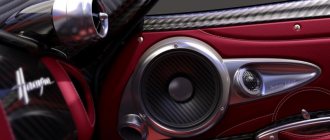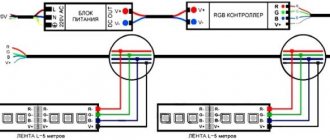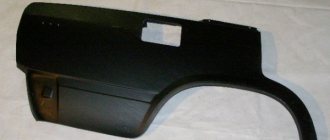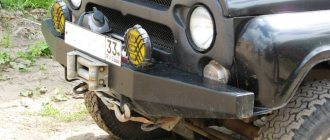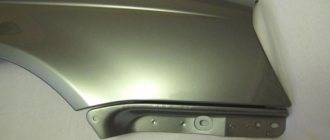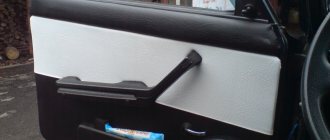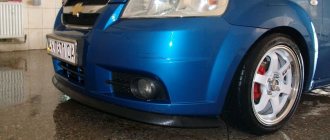The wheel arches of a car are risk elements. This is due to the fact that they are constantly exposed to atmospheric factors: rain, snow, moisture, chemically active components that are often present on the highway. And also crushed stones and small stones flying from under the wheels of cars. IN As a result, pockets of corrosion arise that lead to the destruction of this part of the car.. The rear arches of the car, consisting of an inner part and an outer wing, are especially affected in this regard.
If we are talking about minor defects, you can get by with cosmetic repairs. If we are dealing with very pronounced foci of corrosion, we will need serious repairs or even replacement of the car's wheel arches . To do this, you can seek help from a car service station or do all the work yourself.
Replacing the rear arch and wing of the car
Self-repair of the rear arches of a car can be performed using 2 methods:
- puttying;
- welding
The first method is used when the wing is not rotten to the point of holes, and we are able to obtain a solid surface by removing all the rust. If the destruction led to the formation of holes, it is obvious that puttying is not enough - you will have to take the welding machine out of the cabinet.
Puttying
So, if we are talking about minor damage, the putty method is used. Step by step it looks like this:
- It is necessary to thoroughly wash and dry the car.
- Remove all bare metal rust from the damaged areas and sand them thoroughly.
- Treat areas with reactive primer and allow the surface to dry.
Car rear arch putty
- Place acrylic filler on top of the reactive layer - under no circumstances should putty be applied to acidic primer.
- After the acrylic has dried, apply putty and wait for it to dry.
- Thoroughly sand the dried putty, gradually reducing the grain size of the abrasive. Thus, level the surface, preparing it for painting.
- Paint those areas of the car that have been repaired.
Popular manufacturers
Foreign and Russian companies are engaged in the production of specialized car fender flares. The most famous and reputable manufacturer is Bushwacker (USA). The plant produces a wide variety of additional accessories for cars. Bushwacker products are of high quality and resist the destructive effects of salts and acids, as well as ultraviolet rays. A distinctive point: the company includes fastening elements with its products.
Welding method
If the surface is so corroded that puttying is not possible, you will need welding. Obviously, to carry out work of this kind with your own hands, you must have a welding machine and have the appropriate skills to handle it . So, repair by welding looks like this:
Rear arch repair using welding
Subaru Impreza 1999, 125 l. With. — body repair
Subaru Impreza, 2005
I have blog posts on this car about the life of the repaired arches. The biggest problem is to properly sandblast the inside. When sandblasting, the person did not remove the wheels in order to crawl up properly, so he could not process the arches properly. the second reason is the wrong soil. I was told epoxy. in fact, there was some kind of simple problem (I already found out about this later when, a few weeks later, I came to the painters and drove the car in wet weather with the arches primed). third - the arches were not completely processed. in places where the molding was not sandblasted. therefore, after a year, dots (small) appeared in places where they had not sandblasted from below near the moldings. and after 2 years a bubble appeared in the sandblasted area. Every year a little swelling was added around the holes. As far as I know, the next owner opened the arches last summer because he was welding the rear side members and took the arches for company because they had lost their presentation.
Replacing a car wheel arch with your own hands
If the surface of your car's wheel arches is hopelessly corroded by rust and cannot be repaired, you will need a replacement - this operation will not be difficult to perform on your own.
Let's consider step by step how to replace the wheel arches of a car with your own hands:
- We order the production of a new arch from any turner. The material you can choose is some light alloy like aluminum.
Replacing a car arch with your own hands
At this point we can consider the work completed if you have the skills to handle a welding machine . It won't cause you any particular difficulties.
The arch is welded over the wing with an overlap
Rivets
This method not only repairs large holes in the car body, but also replaces parts (fenders, aprons) without welding. In terms of reliability, it is not inferior to welding. It is recommended to install rivets in an inconspicuous place. Since there is no splash of molten metal during operation, like welding, it is often used to repair car floors.
The riveter required for the job can be bought in a store (costs approximately 500 rubles). The technology is simple:
- The patch is cut so that it overlaps 2 cm around the edges of the hole.
- By attaching it to the body, it is given the desired shape.
- The locations of the holes for the rivets are marked.
- After drilling the patch with a drill according to the diameter of the rivets (4 - 6 mm), it is advisable to countersink the edges of the holes so that it fits more tightly to the surface of the car body.
- Having applied the patch again, the center of the first hole is marked and drilled.
- After riveting it and leveling it, the patches are tapped and the remaining holes are drilled in place.
- To ensure a tight fit of the patch to the car body, rivets are fastened from the center to the edges.
- To prevent moisture from getting inside, the joint around the perimeter and rivets is coated with sealant.
Arch repair prices
Local painting of the inside of the arch per day 1000–1500 rubles. Local painting of the front arch per day 1000–1500 rubles. Local painting of the rear arch per day 1000–1500 rubles. Complete painting of the wing arch 1 day 1500–2000 rub. Full painting of the front arch 1 day 1500–2000 rub. Complete painting of the rear arch 1 day 1500–2000 rub.
Scratches and scuffs
Shallow (superficial) 15 min 400 rub. Average per day 1000–2000 rubles. Deep 2 hours – day 1000–2500 rub.
up to 5–10% of the part area 1 day 1000–1500 rub. over 10–15% of the part area 1 day 1000–2000 rub.
up to 5 cm 2–4 h 500–1000 rub. up to 10 cm per day 1000–1500 rub. up to 15 cm per day 1500–2500 rub. up to 20 cm 1-2 days 1500–3000 rub. over 20–25 cm 1-2 days 2000–3500 rub.
Removing and installing the wheel arch trim (extender) 15–30 minutes from 300 rub.
Trunk repair from RUB 3,000. Bumper repair from 2000 rub. Door repair from RUB 3,000. Wing repair from 2000 rub. Mudguard repair from 1000 rubles. Spar repair from 1000 rubles. Threshold repair from 2000 rub.
Varieties
The following materials are used for the production of mudguards:
- plastic. But according to experienced drivers, this material is not strong enough. Plastic wheel arch extensions perform a decorative rather than a protective function;
- fiberglass. It has great strength, but the cost is usually high. They are quite difficult to install;
- fiberglass. It is distinguished by its high elasticity and resilience; this material is often used to make do-it-yourself overlays;
- rubber - recently it was the only material for the production of fenders. It is characterized by elasticity and practicality, thanks to this it does not lose popularity even now. Rubber wheel arch extensions are universal and suitable for any car model. Their only downside is that rubber fenders do not have an elegant design;
- cable plastic is an economical option with excellent characteristics, and it is also easy to install;
- Duraflex is the best material for the production of expanders. It is elastic, resistant to the aggressive effects of natural factors, does not deteriorate under the influence of ultraviolet rays, and adheres well to the surface.
Rubber wheel arch extensions are the most common because they are practical and easy to install.
Arch repair scheme
Repair procedures vary depending on the type of damage (scratches, dents, rust, etc.). As an example, we will give a simplified scheme for repairing an arch in the event that it is rotten only in one small area, but through and through.
- Step 1 Cost assessment. You have two preliminary options for estimating the cost of arch repair - call and tell us everything in words or send us photographs (videos) of the damage. The specialist will tell you the cost, which does not change in 80% of cases (you will find out why this is later).
- Step 2 Arrival at the service center. Having decided to contact us for help, you need to choose a convenient day and time to come to the service - contact us in any convenient way. You will find all possible communication options on the contact page.
- Step 3 Inspection. You have arrived at the service. The technician put the car on a lift and inspected the damage. If the technician finds damage that was not identified before coming to us, then he will tell you everything, show you and offer options, and you will already make a decision.
- Step 4 Spare parts. There are two options for fixing the rotten part of the arch - installing a patch or sealing it with fiberglass. After consultation with the master, you will choose the appropriate option for yourself. Metal rots, plastic does not. For example, let's assume that metal was chosen to replace the area.
- Step 5 Repair. The master will cut out the rotten area, clean it, weld a patch, sand it, sand it, treat it with various metal compounds, putty, prime it, paint it, dry it and polish it - he will carry out a cycle of work.
- Step 6 After repair. You will carefully examine the master’s work and accept it, or if there are any comments, then express them. although there are almost no comments on our work. If you have any questions, ask them to the master, and he, in turn, will tell you some specifics, for example, how long it takes to wash the repaired area (the timing depends on the materials used). That's all!
Arch extenders (bushwhackers) on the UAZ Hunter, their purpose:
- Protection from external influences of dirt, gravel, etc.
- The effect of strengthening body elements.
- Allows the installation of large diameter wheels and widening of the track.
- Improving the appearance of the SUV.
Arch extensions Hunter – Properties:
- Self-healing effect under moderate external mechanical influences.
- Accurate repetition of the lines of the car body geometry.
Extenders for Hunter – Characteristics:
Material LLDPE* (Elaston**) (Notes: *LLDPE High-density low-pressure polyethylene according to GOST. “Elaston” is a material based on LLPDE, with the addition of elastic properties, internal development of the company).
Power expanders (Lapters) UAZ Hunter – Self-healing effect of the material. The polymer material used in the production of power expanders on the UAZ Hunter, unlike materials based on ABS and fiberglass, does not break, does not crack and is more resistant to ultraviolet radiation.
Full equipment and installation allow you to upgrade your car yourself. High-quality packaging ensures the safety of expanders during transportation and loading and unloading operations.
Arch extensions for UAZ Hunter (they are also called fenders for UAZ Hunter) - strength test:
UAZ Hunter arch extensions - we always have more than 10 sets in stock.
Overall dimensions of the shipment: 1200mm x 810mm x 210mm, weight – 8 kg. We will send it to your region via a convenient shipping company. At the top, select which arch extensions you need and click the green button at the top right “Place an order”. Or you can use the form below to pay for your order online
Please note that this form can be used only if there are branches of the following transport companies in your city: TK KIT (GTD), TK Energia, TK PEC, TK Business Lines. In all other cases, before paying, you must clarify the possibility and cost of delivery by first placing an order at the top right
Useful information about wheel arch repair
If you want the front and rear wheel arches on your car to look great and not show any defects, contact us. Our service specialists will perform high-quality repairs to arches, regardless of the degree of damage. We have at our disposal modern equipment, materials and tools for the complete restoration of the body and its components, and the craftsmen thoroughly know the nuances and features of this type of work.
Types of damage and ways to eliminate them
When operating a car, the arches receive different types of damage:
- Chips, peelings, cracks in paintwork;
- Surface corrosion;
- Severe damage to the metal by rust, up to the formation of holes;
- Dents, changes in geometry, surface breaks as a result of impacts;
These defects are equally inherent in both the front and rear wheel arches. But the complexity of restoration of arches varies. At the rear, the arch consists of two parts - external and internal, connected into a single structure by a permanent connection. At the same time, the rear wing itself with the arch is part of the rear part of the body and cannot be removed. The front fender can be removed from the car, which simplifies the process of restoring it.
Based on the degree of damage, a restoration technology is selected, of which several are used for arches:
- Cosmetic repairs (for damage to paintwork and surface corrosion);
- Straightening (dents and geometry changes are eliminated);
- Sealing holes;
When redecorating an arch, craftsmen clean its surface down to the metal, treat it with corrosion inhibitors, followed by putty, primer and painting.
Note that painting work is necessarily included in the process of restoring wheel arches. They are the final stage for any type of body repair.
Dent removal and straightening
In a garage environment, small dents are often repaired with fiberglass and putty. But this repair is incorrect, although in this way it is possible to restore the geometry of the surface. The essence of the work comes down to filling the dent with layers of fiberglass and putty, followed by sanding to give the required shape. And then the surface is painted over.
The disadvantage of this method is the need for thorough surface preparation, which is not always done. Therefore, corrosion often forms under the applied materials. Also, a layer of putty that is too thick eventually cracks along with the paintwork and the defect on the arch becomes noticeable again.
To restore the geometry of the arch surface, we straighten it. Using specialized equipment and tools, craftsmen level surfaces to an almost ideal state, regardless of the complexity of their shape and the number of creases.
To remove dents we use:
- slipway;
- Spotter;
- Reverse hammer;
- Hammers and extensions for straightening;
After straightening, the putty is used only to seal the smallest defects, so the thickness of the applied layer is insignificant and it will not crack in the future.
Filling holes
The most technologically complex operation is filling holes and replacing the arch in case of severe corrosion. Car enthusiasts often use fiberglass for this, which is also wrong. This method comes down to cleaning the surface, treating the edges of the holes with chemicals. means to prevent further spread of corrosion and fill the rotted area with fiberglass. After this, the surface is given the desired shape by puttying and sanding, followed by priming and painting.
It is better to remove holes on wheel arches by welding. We repair arches like this:
- We determine the size of the damaged area and make markings;
- We cut out replacement metal;
- Cut out the rusty part of the arch or its entirety (when replacing);
- We weld the prepared metal;
- We clean the welds;
- We treat the seams and adjacent areas with anti-corrosion agents;
- We putty and sand the arch to give the desired shape;
- We carry out painting work.
Note that this is a general algorithm for restoring arches by welding. Each specific case of repair has certain nuances and features that we take into account.
Whatever the condition of the arches on your car, we will fix them. You can evaluate the quality of arch restoration performed by our masters from the photos below.
How to choose materials for proper car sound insulation
Due to the huge range of insulating materials, it is difficult to make the right choice. When selecting a product, the car owner must take into account the following parameters:
- Specific gravity (not in all cases should be large). Some modern materials are able to dampen vibration due to their technical characteristics, for example, due to the plasticity and internal design features of the fibers. However, formulations that are too light should not be purchased, as their effectiveness will be low. It is better to take vibration-proofing material with an aluminum (reinforced) layer with a thickness of 0.1 mm. If the thickness is very large, then efficiency will not increase much, while installation will become more complicated and the price will increase.
- MLC, or mechanical loss coefficient, measured as a percentage. It is believed that the higher this indicator, the better (the norm is from 10 to 50%). The sound loss coefficient (SLC) characterizes the absorption of sound waves. The higher the indicator, the better (the norm is from 10 to 50%).
These two parameters are the main ones, in most cases decisive when choosing. But in addition to these, additional factors should be taken into account:
Plastic. Affects the tightness of contact with the surface of the car body.
Ease of installation. You need to choose noise and vibration insulation materials either separately or one universal one
It is important to choose the right additional tools: a hair dryer, a roller, etc. Easy installation helps save money, as it allows you to do the work yourself, without turning to specialists
Long service life
The higher the number, the better. Information about the warranty period can be found in the instructions. Experienced car enthusiasts will say a lot about the durability of a particular brand of vibroplast (and which car sound insulation to choose), based on personal experience.
Resistance to mechanical stress. Throughout the entire service life, materials should not change their characteristics and shape. But, as a rule, sound insulation is installed in areas where it, in principle, cannot be deformed.
The thickness parameter affects the choice of areas that will be glued (from large areas to small joints of plastic parts).
Qualitative characteristics of mastic. Not only vibration isolation or noise insulation properties are important. It happens that when heated, inexpensive mastic of poor quality during the installation process for soundproofing a car becomes liquid, begins to flow out of the sheet and spread over the entire area of the surface being treated. Therefore, it is better to beware of purchasing such a product.
Matching quality and cost
It is important to adhere to this rule in the same way as when choosing any other product. You shouldn’t throw money away buying expensive insulation to treat a cheap domestic car.
It is better to purchase expensive and high-quality material for the purpose of installation on a foreign car from the middle price range.
Of great importance is the adhesion indicator, that is, the level of adhesion of different-sized surfaces of solid and/or liquid substances. Fastening requires a certain amount of force from the insulating material to adhere to the surface being treated. As a rule, the manufacturer prescribes this parameter. But some unscrupulous manufacturers provide false information, thereby misleading car owners. The optimal adhesion index is 5–6 N per 1 cm². We can talk about a marketing move in the event of a large increase in this value specified in the instructions. As practice shows, the above adhesion value is quite sufficient for the material to adhere well to the surface.
Of course, the choice largely depends on the name of the trading company (brand) that produces soundproofing products. The most famous and recognized manufacturers, whose products are widely distributed in Russian markets: Dynamat, STP, Kics, Shumoff, etc. Each of the above companies has several product lines in their arsenal.
Types of fiberglass fillers
DIY bumper repair
The term “fiberglass” is derived from the English. “FiberGlass” literally means “fiberglass”.
However, everyday speech has transformed this term as the name of glass-filled plastics, in which various glass fiber materials serve as fillers.
By analogy with reinforced concrete, glass fibers act as reinforcement, ensuring the rigidity of the structure and the strength of the SPM, and synthetic resins bind the filler threads into a single matrix, creating a monolithic structure.
The raw material for the production of glass fibers is glass scrap (cullet), the sources for which are:
- broken window glass and glass containers;
- rejected or broken products created under production conditions.
Glass waste is 100% recyclable, which proves the priority of recycling cullet to save primary raw materials and maintain a clean environment.
Broken glass does not fall into the soil and does not pollute landfills.
Virgin glass fiber is formed into a continuous glass filament by drawing elementary fibers called filaments from molten recycled glass raw material.
After further processing, semi-finished products are formed from the filaments:
- complex threads;
- glass rovings are strands of untwisted fibers (analogue of roving).
In this form, glass fiber is practically not used as a filler.
The resulting semi-finished products are subjected to textile processing to create products that will be directly used as a filler in the molding of fiberglass products.
The main types of fiberglass filler are:
- twisted products - cords, plaits, twines;
- woven mesh and special structure;
- fabrics – ribbons, mats, canvases.
Types of fenders
Wheel arch extensions are presented on the modern market in several variations:
- universal. These are rubber pads sold in rolls. The use of such parts has no restrictions on the make or model of the vehicle - when installed, they can easily be adjusted to any arches. But despite the excellent protective properties, universal arch extensions do not have an elegant design and significantly worsen the appearance of the car, which is why they are most often purchased by SUV owners;
- plastic. They are attractive, but are produced for a specific model. Fixation to the body is carried out using self-tapping screws. A significant disadvantage of plastic wheel arch extensions is the low level of protection and fragility, so they are most often used for beauty;
- fiberglass. The pads are quite durable and look like plastic ones. Most often they are made by hand or made to order;
- fiberglass. They are characterized by excellent appearance, as well as good protective qualities. They are quite expensive. In addition, the installation of these elements is a labor-intensive and complex process. To install such a wheel arch extension, you must first clean its surface and apply a layer of putty. After this, the trim is aligned with the car body, secured with self-tapping screws and painted with the appropriate shade of paint.
Wheel arch extensions are presented on the modern market in several variations
Roving spraying
The process is technologically advanced and cannot be carried out without special tools. The essence of the method is that glass thread (roving) is crushed, mixed with resin and applied to the surface. The grinding gun prepares the composition and delivers it under pressure in the form of a finely dispersed substance. But after application, rolling with a roller is required, which ensures the removal of air bubbles.
Useful to know > Basic principles of working with polyester resin, its features
The simplicity of the technology is visible only theoretically. Only “on paper” the essence of the method was contained in a couple of lines. In fact, the method has not become widespread, and the point is not in the presence of a special tool. The reason lies in the excessive consumption of epoxy resin. The product itself becomes massive, and in the absence of interlacing of fibers, the strength of the layer leaves much to be desired.
Garage storage - what to consider in this case?
Many car owners take car after car and sell it again because they notice corrosion spots all over the body. In this case, it may not be the deceiving sellers who are to blame, but your garage. Creating a humid atmosphere in the garage is unacceptable at any temperature and changes; in such conditions, the car will gladly rot before your eyes. It is better to simply avoid such exposure by obtaining optimal performance characteristics of the body parts.
The main features of a proper and safe garage are as follows:
the presence of exhaust ventilation - this type of ventilation hole is located in the upper part, it must be fully open and always work to extract air from the volume of the garage; supply ventilation is also an always open ventilation hole, which is located in the lower part and works to draw in air from the street to compensate for the exhaust; the absence of barriers to the ventilation air flow, otherwise the exchange will not be sufficient, which will lead to very unpleasant consequences in terms of the service of body elements; absence of condensation on the garage door during periods of temperature changes outside, this factor must be taken into account, since condensation is the main element in the development of corrosion on the body; optimal temperature conditions, which are not very different from the street temperature or are always in the same range, this is important for preserving the car from various influencing factors.
As you can see, improper storage of a car can be one of the reasons for its total destruction. So sometimes it is better to store your car outside and this will help prevent corrosion. Of course, improper storage factors cause rust not only on the arches, but also on any body part. On arches this process will be accelerated if there is already some damage and other troubles. It is worth considering this when you choose where to store your car in the future.
We invite you to watch a video about rust on arches:
Fiberglass patch
You can also repair a hole in a car body using fiberglass and epoxy glue. Professionals recommend following the following sequence of repair work:
- Clean the edges of the hole using a grinder or a suitable tool.
- Treat the cleaned areas with an anti-corrosion agent or a rust converter.
- Cut 2-3 patches from fiberglass. It should be noted that the dimensions of each patch should be 30-40 mm larger than the dimensions of the hole and the previous patch.
- Saturate the surface of each patch with epoxy glue. Thanks to this, it will be possible to glue them tightly, preventing the possibility of liquid and moisture leaking from the outside.
- Glued patches are attached from the inside of the body using epoxy glue.
- After the glue has completely dried, cover the surface of the patches with primer or putty.
- At the last stage of repair work, the primer (putty) must be carefully cleaned with sandpaper.
By using one of these methods, you can get rid of holes in the body quickly and inexpensively.
What is the purpose
As a rule, it is impossible to do without a car wash if you go out of town or into the countryside. Even driving on city streets in rainy weather can be a real test for a washer. Wide-profile tires are considered the best tires for such trips, but they protrude far beyond the boundaries of the tires. As a result, all the dirt collected during the trip is scattered in all directions when driving, heavily contaminating the body of the car. This problem is solved thanks to the extended overhang of the body, which is provided by universal wheel arch extensions.
Despite its versatility and usefulness, this idea for car body has not received the desired recognition. Today, standard bodies are still actively produced, which do not fit well with wide types of tires, so drivers independently remake this design.
There is no need for welding work, which degrades the entire structure of the machine. Today you can use linings that are attached to the car body in simple ways, increasing its size.
Ways to solve the problem
Two methods for increasing wheel arches are widely used today. You can make your own special pads or buy ready-made ones. They are represented mainly by the following types:
Applying a patch with a soldering iron
The second method is no less popular among motorists - using a soldering iron.
Just as in the first case, the area where the patch is applied should be thoroughly cleaned of rust. You can cut a patch from an ordinary aluminum tin can.
The quality of the repair can be increased by applying a layer of a compound with anti-corrosion properties to the edges of the hole and the surface of the patch.
After this, use a soldering iron to walk along the edges of the patch. The seam should be uniform and not very thick.
It is possible that the patch will protrude beyond the edges of the body. In this case, you should trim it with a hammer.
When finished, coat the patch with a ball of primer. This step is considered necessary in order to avoid further development of corrosion. The primer is applied in 2-3 layers at intervals of 3-4 minutes.
You can speed up the drying time of the primer by using infrared heating.
What should a high-quality anticorrosive agent look like?
How to repair car thresholds without welding with your own hands Until recently, the choice of a motorist in terms of protective auto chemicals was limited to Movil, gun lard and two or three types of liquid mastics. Today the market offers dozens of options for processing body parts. Despite this diversity, they are divided into anti-corrosion agents intended for treating hidden and external surfaces.
The first ones meet the following requirements:
- high adhesive ability to smooth surfaces;
- the ability to create an elastic film after drying;
- chemical neutrality to metal, plastic and paint coatings;
- possibility of introduction into the metal structure;
- fluidity sufficient to fill the slightest cracks;
- homogeneous structure;
- ability to displace moisture and electrolytes from the surface.
Oil compositions fully meet these conditions. They have excellent penetrating ability and remain in a liquid state for a long time, but due to their low strength they are not suitable for outdoor use. In addition, the retail chain also offers products with a wax base. Like oil anticorrosive for cars, they are applied using a spray gun, but they penetrate much less into the steel structure. The advantages of paraffin compositions lie elsewhere. They adhere equally well to paint and rusty metal, forming a protective film through which neither moisture nor chemicals penetrate.
A number of the requirements discussed above are supplemented with several more points if materials for anti-corrosion treatment of the car are used externally:
- Mechanical strength sufficient to withstand the impacts of gravel flying out from under the wheels and the abrasive effects of dust and sand;
- The ability not to peel off or crack under alternating loads and mechanical deformations of the body.
Modern anticorrosive agents extend the service life of body parts and increase acoustic comfort in the cabin. At the same time, they will be able to fully express themselves only when the application technology specified by the manufacturer is followed.
Final stage
Regardless of how the car body was repaired, they all end with putty. However, it absorbs moisture, which leads to rapid destruction. Therefore, it must be coated on top with an anti-corrosion or epoxy primer. Body repairs are completed without welding by painting. To do this, use a spray gun or aerosol cans, after covering the adjacent surface of the car with plastic film. You should not use a brush, as drips are possible.
The proposed methods will help to repair a car without welding in case of single damage. However, if a large area is affected by corrosion, it will be easier and more reliable to contact a car repair shop to replace the rusted area by welding. Most often this happens to the floor, so it is recommended to regularly check it from underneath the car using an inspection hole or lift.
Fiberglass and mesh
To repair more extensive damage, an aluminum patch mesh is used. A piece slightly larger than the hole is cut out of it and attached with masking tape. Next, sealing holes in the car body without welding is carried out in the following sequence:
- a thin layer of fiberglass putty is applied without touching the tape;
- after drying, the tape is removed;
- subsequent layers of putty are applied after the previous one has dried;
- the surface of the car is treated with sandpaper or a grinding machine until smooth;
- To strengthen the mesh, several layers of putty are applied to the back of the body.
Long-term auto patches are made from fiberglass and epoxy resin. Several overlays are cut from it, the first of which should cover the hole with a margin of 2 cm. The size of each subsequent piece is made larger than the previous one. The last overlay should cover all the metal stripped during the preparation process.
The cut pieces are impregnated with resin and placed on the hole in a sequence of increasing sizes. If you need to seal large holes on the back of the body, use linings to prevent the fabric from sagging. After laying all layers of fiberglass, wait for the resin to completely harden. The time required for this is indicated in the instructions.
Safety measures during work
The main danger during work is the contact of chemicals with human skin. Epoxy resin and hardeners can cause severe skin irritation. Also, resins and hardeners can cause allergic reactions. When grinding, dust may enter the respiratory tract. During the repair process, evaporation of resin, hardener and sanding dust can cause eye irritation.
How to restore a car body using fiberglass is shown in detail in the video.

